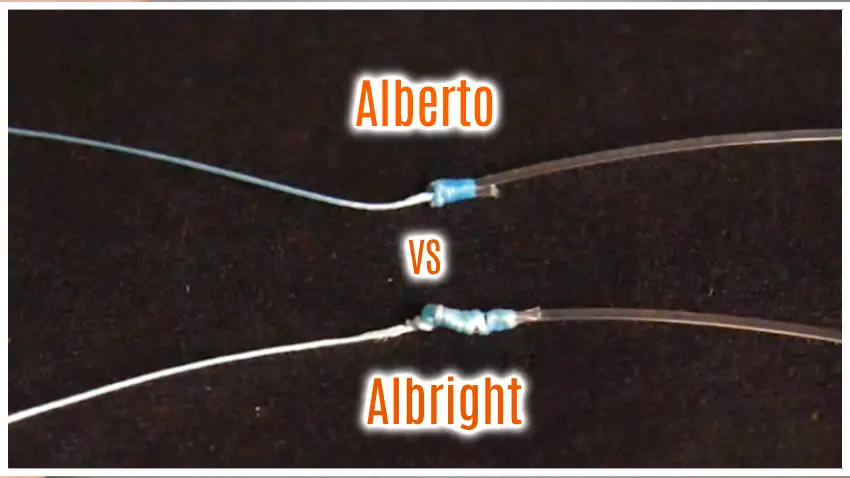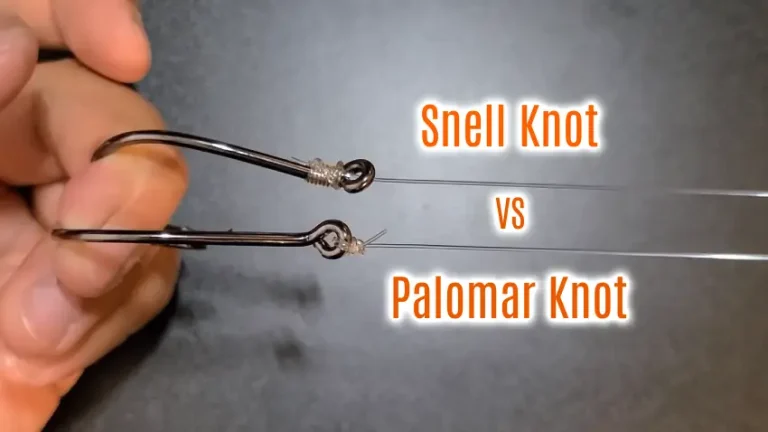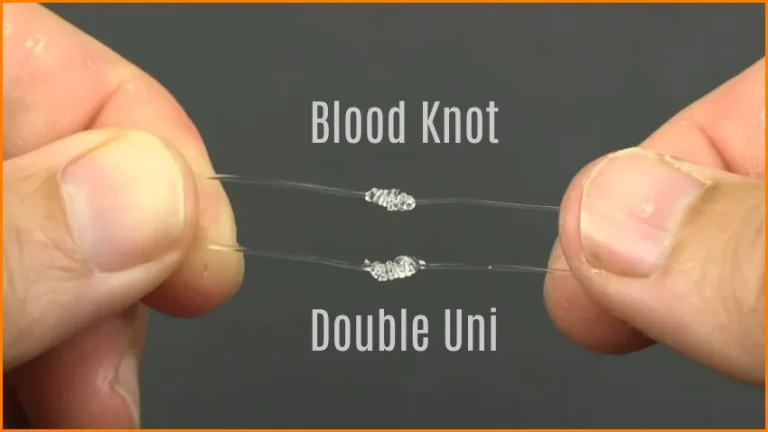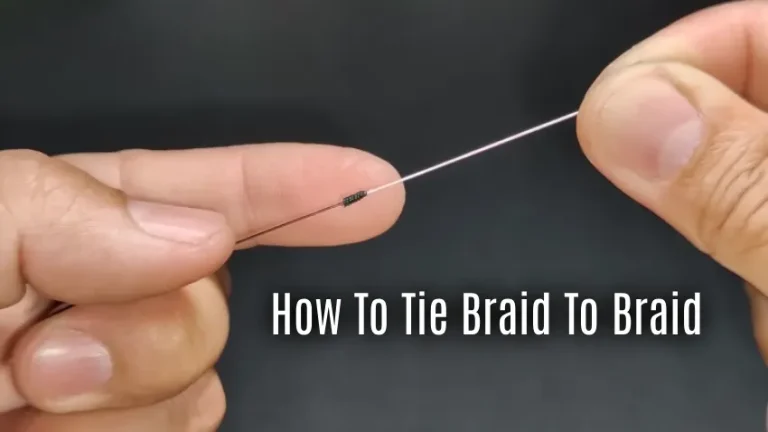Alberto vs Albright Knot: 10 Differences Impact While Fishing
Knot selection in fishing can significantly impact an angler’s success on the water. Two knots often compared in the fishing community are the Alberto Knot and the Albright Knot. Both knots are popular among anglers but have distinct characteristics that set them apart.
The Alberto Knot is smaller and easier to tie, making it a versatile choice for various fishing situations. Conversely, the Albright Knot, while strong due to its double wraps, is larger and more complex, which can limit its applicability in certain scenarios.
Here, we’ll explore the differences between them besides the strength of the Albright knot and why the Alberto knot is ideal for saltwater fishing. Plus, we’ll reveal whether the Alberto knot can be used for fly fishing leaders.
Differences Between Alberto and Albright Fishing Knot
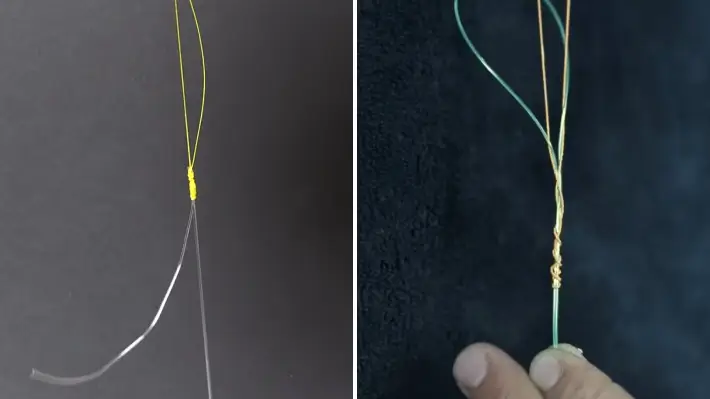
When comparing the Alberto and Albright fishing knots, there are several key points to consider.
- Knot strength
- Knot complexity
- Wrapping consistency
- Back wraps
- Knot size
- Knot versatility
- Knot tying speed
- Line material compatibility
- Tag end management
- Knot popularity and recognition
No 01: Knot Strength
The Alberto Knot offers superior knot strength compared to the Albright Knot. This is due to the way the Alberto Knot is constructed. It involves wrapping the leader line around the main line multiple times, creating a tight and secure connection.
The loops in the Alberto Knot distribute the tension evenly, preventing stress concentration on any single point. This results in a knot that can withstand heavy loads and intense pressure without slipping or breaking.
On the other hand, the Albright Knot, with its double loops, may be bulkier but doesn’t provide the same level of knot strength as the Alberto Knot.
No 02: Knot Complexity
For you, the complexity of the Alberto and Albright fishing knots can be easily distinguished by their differences in knot-tying techniques.
The Alberto Knot is relatively straightforward to learn. It involves simply wrapping the main line around the leader line and then threading it back through the loop created. This simple process makes it widely used among anglers who value efficiency and speed.
In contrast, the Albright Knot is a bit more intricate. It requires double wraps and threading the leader line back through a loop, then wrapping it around the main line multiple times. The additional steps and double wraps make the Albright Knot slightly more complex to execute, but it also adds strength and reliability.
No 03: Wrapping Consistency
To achieve consistent wrapping, you should pay attention to the tension and stacking of wraps in the Alberto and Albright fishing knots.
In the Alberto Knot, achieving perfect tension for the wraps can be challenging. This inconsistency may arise due to factors such as variations in hand pressure or line thickness. Maintaining a steady tension throughout the wrapping process is crucial to ensure the knot’s reliability.
On the other hand, the Albright Knot faces a different issue with wrapping consistency. Getting the wraps to stack consistently can be problematic. It requires careful manipulation and alignment of the wraps to avoid overlapping or gaps.
No 04: Back Wraps
The back wraps in these two knots are crucial to their strength and reliability. In the Alberto Knot, the back wraps are created by wrapping the main line around the tag end multiple times. This helps to secure the knot and prevent slippage under tension.
Conversely, the Albright Knot utilizes back wraps by looping the tag end around the main line and then wrapping it back around itself. This creates a stronger bond between the two lines and enhances the knot’s ability to withstand heavy loads.
No 05: Knot Size
In terms of knot size, the Alberto Knot maintains a smaller profile, making it suitable for various fishing scenarios, while the Albright Knot’s larger size mightn’t be as inconspicuous.
The compact nature of the Alberto Knot allows it to easily pass through rod guides, minimizing any potential snagging or interference during casting. This makes fishing particularly advantageous in areas with heavy vegetation or structure. Furthermore, the smaller size of the Alberto Knot also reduces the risk of creating a weak point in the line.
On the other hand, the Albright Knot’s larger size can be a disadvantage in certain situations. Its bulkiness may be more noticeable to fish, potentially making them hesitant or spooked.
Additionally, the increased size of the Albright Knot may impede the line’s smooth passage through rod guides, causing friction and affecting casting distance.
No 06: Knot Versatility
You can use the Alberto Knot and the Albright Knot for different fishing purposes, but their versatility differs.
The Alberto Knot, when tied perfectly, is highly versatile and can be used in various fishing applications. It’s highly reliable and strong, making it a favorite knot among anglers. Whether you’re fishing with monofilament, fluorocarbon, or braided lines, the Alberto Knot can handle them all.
Meanwhile, the Albright Knot, although useful in certain situations, may not be as versatile as the Alberto Knot. Its larger size and bulkiness make it less suitable for finesse fishing or situations where a smaller, more discreet knot is required.
No 07: Knot Tying Speed
The Alberto Knot is a simple and fast knot to tie, making it an ideal choice among anglers. It consists of only a few steps, involving the wrapping of the leader around the mainline and passing it through the loop created.
Contrary to that, the Albright Knot requires additional steps and precision. It involves creating a loop with the mainline, wrapping the leader around the loop multiple times, and then threading the tag end of the leader through the loops.
These double wraps can be time-consuming, especially for beginners or in situations where time is of the essence.
No 08: Line Material Compatibility
The Alberto Knot is known for its versatility, making it a great choice for different line materials. Whether you’re using fluorocarbon or braided lines, the Alberto Knot can handle it all. It provides a strong and secure connection, ensuring your line stays intact during those intense fishing battles.
On the other hand, the Albright Knot may not be as adaptable when it comes to fluorocarbon lines. It may struggle to grip the smooth surface of the fluorocarbon, leading to potential slippage and weakened connections.
No 09: Tag End Management
Regarding the Alberto Knot, you’ll be pleased to know that it typically doesn’t require additional measures to secure the tag end. Once the knot is tied and tightened, the tag end can simply be trimmed close to the knot without any worries.
Conversely, the Albright Knot may require some extra attention. After tying the knot, securing the tag end with a few half hitches is recommended. These additional loops will help to cover and protect the tag end, ensuring that it doesn’t unravel or get snagged on anything while you’re out fishing.
No 10: Knot Popularity and Recognition
For anglers, the popularity and recognition of the Alberto and Albright fishing knots differ due to their distinct characteristics and applications.
The Alberto Knot has gained widespread recognition and popularity within the fishing community for its versatility and reliability. Its slim profile, smooth finish, and high knot strength make it a favorite among anglers.
When braided mainlines are connected to fluorocarbon or monofilament leaders, the Alberto Knot is a popular choice.
On the other hand, the Albright Knot, while still valued by some anglers, may not be as widely recognized or popular as the Alberto Knot. Its bulkier profile and complexity make it less desirable for certain applications
However, the Albright Knot can still be an effective and dependable choice for heavier lines and connections.
Comparison Table Between Alberto and Albright Fishing Knot
| Aspect | Alberto Fishing Knot | Albright Fishing Knot |
| Knot Strength | Strong but smaller | Strong but larger (double wraps) |
| Knot Complexity | Relatively easy to tie | Somewhat more complex due to the double wraps |
| Wrapping Consistency | Some inconsistency in tension | Difficulty in getting wraps to stack consistently |
| Back Wraps | Tension issues during back wraps | Tension issues during back wraps |
| Knot Size | Smaller and more compact | Larger due to double wraps |
| Knot Versatility | Versatile when tied perfectly | It may not be as versatile due to the size |
| Tag End Treatment | Typically, no additional treatment | It may require trimming or securing the tag end |
| Knot Tying Speed | Quick and straightforward | Slower due to double wraps |
| Line Material Compatibility | Works well with different line materials | It may not be as adaptable with fluorocarbon |
Is the Albright Knot strong?
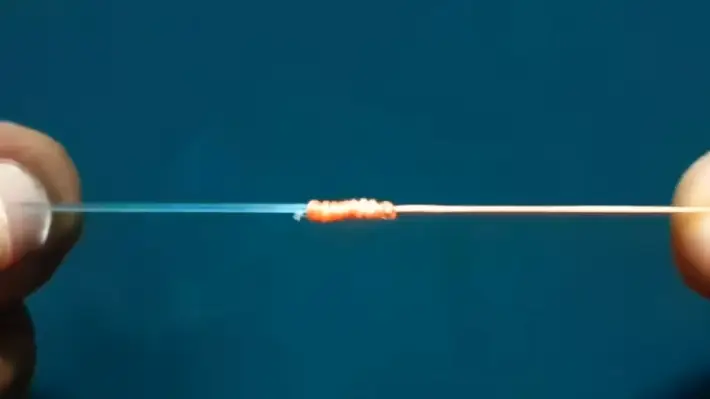
The Albright Knot is known for its strength and reliability, making it a popular choice among anglers. Whether you’re using mono, fluoro, braid, or even wire, the Albright Knot provides a secure line-to-line connection.
Fly fishermen especially favor this knot for joining fly lines to the backing. Its compact design ensures it won’t slip or come undone, giving you peace of mind while on the water.
The Albright Knot can handle the tension and pressure of reeling in a big catch, making it a go-to knot for many experienced anglers. With the Albright Knot, you can trust that your line will stay connected, no matter the fishing conditions.
What makes the Alberto Knot suitable for saltwater fishing?
You’ll find that one of the reasons the Alberto Knot is suitable for saltwater fishing is its exceptional strength and durability. When you’re battling against powerful saltwater species like tuna or marlin, you need a knot that can withstand the intense pressure.
The Alberto Knot is designed to do just that. Its compact size allows it to pass through the guides smoothly, reducing the chances of snagging or breaking. Additionally, the knot maintains high strength, ensuring that your line stays securely attached to your hook or lure.
Can the Alberto Knot be used for fly fishing leaders?
The Alberto Knot is a versatile knot commonly used for connecting different fishing lines, including monofilament, fluorocarbon, and braided lines. It’s popular among anglers because of its small profile and reliable strength.
Regarding fly fishing in Wyoming, the Alberto Knot can connect the fly line to the leader or tippet material. This knot ensures a smooth transition between the fly line and the leader, allowing for precise and accurate casts.
The Alberto Knot is known for its stronghold, which is crucial when fishing larger fish. It’s a reliable knot that will help you land more fish while fly fishing.
Alberto or Albright Knot: Get One for Successful Fishing
While the Albright Knot is highly regarded for its strength, the Alberto Knot is particularly suitable for saltwater fishing because of its durability.
The Alberto Knot, with its smaller size, ease of tying, and versatility, is a go-to choice for many. In contrast, the Albright Knot, though strong and dependable, may be better suited for specific applications due to its larger size and double wraps.
Anglers should consider the specific demands of their fishing scenarios and the attributes of each knot when deciding which one to tie. With this knowledge, they can confidently approach their next fishing adventure, knowing that the choice of knot is one element of their gear they’ve mastered.

